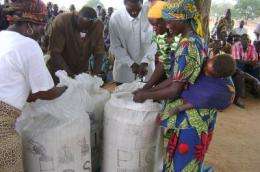Hermetic bags save African crop, but not how experts once thought

The hermetic grain storage bags that cut off oxygen to weevils and have saved West and Central African farmers hundreds of millions of dollars by putting the brakes on the insects' rapid multiplication don't merely suffocate them as once thought, a Purdue University study shows.
More than 25 years after introducing the Purdue Improved Cowpea Storage (PICS) bags to farmers in Africa, Larry Murdock, a professor of insect physiology, discovered that weevils produce much of their water themselves through metabolic processes. When oxygen in the bags decreases, the weevils cannot use it to create water, and instead of suffocating, they eventually die of thirst.
"When you and I want water, we go to a water fountain or grab a bottle of water," Murdock said. "Insects cannot do that, especially those living in dry grain. They have to get it someplace else."
Murdock's findings were reported in the early online version of the April issue of the Journal of Stored Products Research.
Murdock led a team in 1987 that developed the PICS bags as a way to combat weevil infestations in Cameroon that discouraged farmers from storing their own harvested cowpea grain. A female weevil can have as many as 100 offspring in one month, so just a few can cause significant loss in a short amount of time.
"After three or four months, everything is destroyed," Murdock said.
So, farmers often sold everything at harvesttime, which limited their financial return.
"At harvesttime, grain was at its lowest price because there was an abundance of it," Murdock said. "They couldn't store their cowpeas to eat later because of the weevils, so they would sell everything in the fall. Later in the year, they had to buy cowpeas, an important food, which by then cost two to three times as much. They would sell low and buy high. It's a very bad situation."
With the PICS system, farmers place their cowpeas in a polyethylene bag and seal it. The bag is surrounded by another, identical bag and sealed, and the double-bagged crop is held within a third, woven nylon bag. All of the materials are cheap and increasingly available in cowpea-growing regions.
The PICS program is in 10 African countries now, and the goal is to have more than half of all cowpeas stored on farms in West and Central Africa in PICS bags by 2012. Jess Lowenberg-DeBoer, Purdue associate dean and director of International Programs in Agriculture, said more than 1.75 million bags have been sold in West and Central Africa in the last five years. Demonstrations on the bags' effectiveness have been done in more than 31,000 villages. The program is expecting 3.4 million households to adopt the PICS bags, saving them about $150 annually ╨ about half a billion dollars per year in saved grain each year overall.
To understand what was going on inside the bags, Murdock used a Purdue insect feeding monitor he and colleagues developed at Purdue more than 20 years ago to hear the ultrasonic sounds of the feeding weevils hidden inside cowpeas.
"The insects are like hard-rock miners chipping away to get something to eat," Murdock said.
Changes in those sounds can be used to determine changes in the weevils' activities. Murdock said tests showed that increased carbon dioxide concentrations did not stop the insects from feeding, but reduced oxygen concentrations did. At oxygen levels low enough, the weevils stopped feeding.
"The PICS bags, a form of hermetic storage, work because depriving the insects of oxygen causes them to cease feeding. This leads them to stop growing, developing and reproducing, which prevents them from becoming a problem," Murdock said.
Murdock calculated that an average weevil needs at least 7 milligrams of water over its lifetime, but it could only get about 1.4 milligrams from the moisture trapped in the cowpeas they eat.
He and former Purdue doctoral student Venu Margam also found that weevils use about 9 milliliters of oxygen during their lives inside the seeds. That 9 milliliters, combined with carbohydrates from food, result in the production of carbon dioxide and water. When he did the math, Murdock discovered that a weevil would produce about 7 or 8 milligrams of water metabolically in its lifetime.
"That's the major source of water for the insect, namely metabolism," Murdock said. "We now know that many of the insects inside the bags die from lack of water. They dry up."
Murdock said that while the discovery answers questions about the process, it also suggests ways to improve it. This works reveals that lowering moisture content would enhance the technology's effectiveness.
Murdock and African collaborators are testing the technology in other countries that experience insect infestations in their stored crops. Research is under way to see if it could be useful for beans, corn, sorghum and other grains.
"We believe the benefits of this insecticide-free, low-cost way of storing grain will be manifold," Murdock said.
Provided by Purdue University















